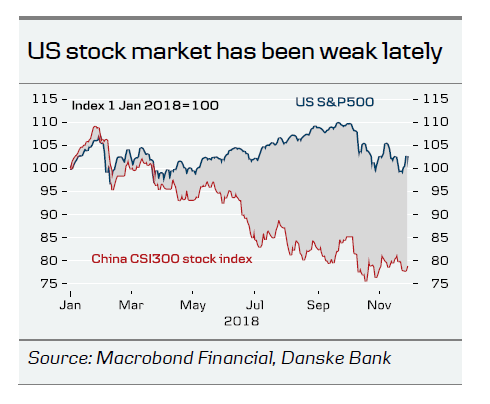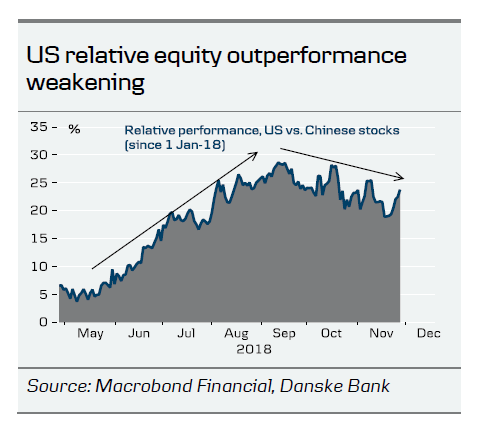We have received a lot of mixed signals in recent days, we still stick to a 60% probability of a ceasefire in the US-China trade war after the G20 meeting over the weekend (dinner to be Saturday evening). This should be positive for risk markets. We see roughly five reasons.
1. Trump initiated the talks this time. Since leaving the negotiation table in May and starting the trade war, Trump has several times said that ‘now is not the right time to talk to China’. The fact that Trump initiated this round of talks by first calling Chinese President Xi Jinping and then preparing for a ‘meeting plus dinner’ at the G20, suggests that Trump has changed his view and now believes it is the right time to start talking again.
2. Trump’s hand starting to weaken? The reason that Trump has taken the step to meet with Xi could very well be related to the fact that US stock markets have started to wobble. Trump has been boasting that Chinese markets were collapsing and US markets were strong. This picture has changed recently as US markets have suffered a set-back, whereas Chinese markets have actually stabilised. Hence based on pure relative stock market performance, Trump’s hand has weakened a bit lately. Using Trump’s ‘Art of the Deal’ logic, his philosophy is to put maximum pressure on his opponent. But the pressure may decline if it becomes clearer that the US will also pay a price for a trade war.
3. Further escalation could back-fire. If the US and China do not reach a ceasefire the next step will be at least a further increase in tariffs on 1 January from 10% to 25% on USD200bn worth of Chinese goods. In addition a further escalation with 10% tariffs on the rest of imports from China, corresponding to USD267bn, would start to have a bigger impact on US manufacturers and consumers. Companies are increasingly starting to complain about the tariffs and consumers would also feel more pain. China’s response could slowly start to be a boycott of US consumer goods such as iPhones and GM cars. It would hurt the stocks of many US companies with high exposure to China – and hence add to the stock market headwinds. A consumer boycott may not be orchestrated from Beijing but could simply be triggered by some Chinese celebrities urging a boycott on social media. While Chinese consumers like US consumer brands, their patriotism should also not be underestimated. If the Chinese economy faces serious pressure due to US tariffs, consumers would likely start supporting their own products.
4. China unlikely to increase concessions even if Trump adds more tariffs. It is very doubtful that Trump would achieve much by adding more tariffs on China. He may of course think so and do it anyway, but China will probably stretch them as far as they are willing to go in this round of talks. China will not give concessions that it believes will hurt the economy in the long term. It would rather pay the short term cost of facing higher tariffs.
5. China will demand a ceasefire to enter a new round of negotiations. China has many times stated that it will not be bullied by the US, and that negotiations should take place with mutual respect and equality. It will not negotiate with a gun to its head. It is therefore unlikely that they will continue talks if Trump moves on with the tariff on 1 January as he indicated in the interview with Wall Street Journal on Monday. Instead China can be expected to retaliate one way or the other.
The mixed signals in recent days from Trump and his economic adviser Larry Kudlow have added some uncertainty up to the meeting. However, we do not think it is a coincidence Trump does an interview with Wall Street Journal so shortly ahead of the meeting with threats to add more tariffs on China. In his book ‘Art of the Deal’ one of the 11 rules is that you should ‘use your leverage’ and ‘the worst thing you can do is seem desperate to make it’. Another point he says is ‘One thing I’ve learned about the press is that they’re always hungry for a good story, and the more sensational the better’. Hence he is clearly very conscious of how to use the media to send signals.
Of course there is a risk that Trump will simply not be satisfied with Chinese concessions and continues the trade war. We put this probability at 40% – so still quite high. In our view, it would be ‘overplaying’ his hand, as he is unlikely to get much out of China as indicated above – and it would increasingly hurt the US economy. He will likely need to have a final deal in place before he enters into the 2020 election year as one of his key campaign promises has been to fix the bad deals with China made by previous presidents. As it will take time to negotiate all points he will need to get started soon.
A ceasefire and plan for further talks
A deal at the dinner after the G20 meeting would not be a fully-fledged final deal. Rather it would probably be similar to the agreement between the US and EU in which no tariffs are implemented while talks move on.
A ceasefire could also include a framework for further negotiations with a list of areas that needs further negotiation. It may also include areas, where China will commit to concessions – such as opening up further, increasing protection of intellectual property rights, more buying of US goods in agriculture and energy (without a specific amount). China will also aim for a US commitment to WTO reform and a system of multilateralism.
The first hurdle will be the actual G20 meeting
Before getting to the US-China meeting on Saturday evening, the two countries need to cross the first hurdle of the actual the G20 meeting. There will most likely be pressure from other G20 leaders to stop the trade war as it is one of the main risks for growth over the coming year. WTO reform will be on the agenda, and a framework for reform will be hard to agree on. Finally, it will be interesting to see if they are able to agree on a joint statement. The APEC meeting in Papa New Guinea recently ended without a joint communiqué for the first time in its 29-year history – apparently because the US insisted on certain language that China would not accept.















